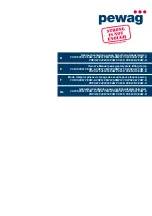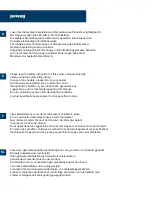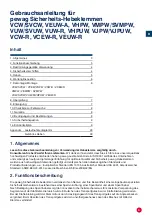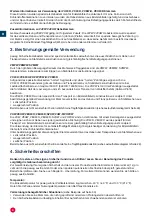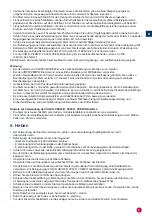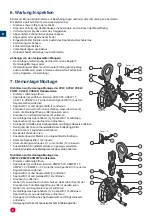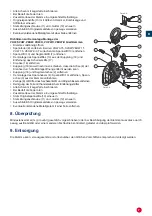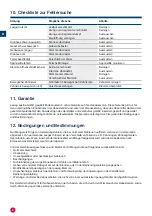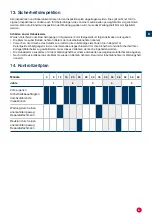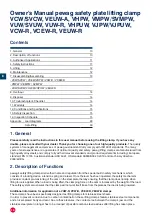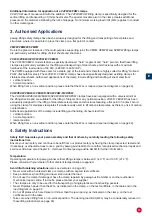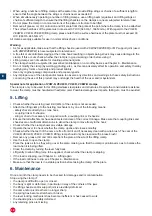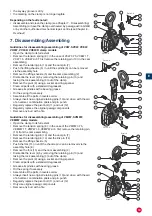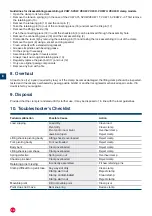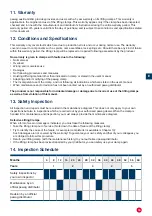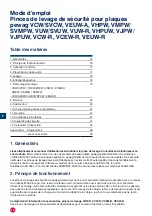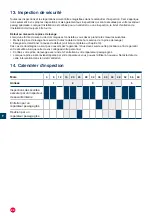
E
11
Additional information for application of a VJPW/VJPUW clamps
VCW/ VUW user's manual valid with the addition: The VJPW/VJPUW lifting clamp is specifically designed for the
vertical lifting and transporting of (thin) sheet metal. The special movable pivot in the clamp creates additional
pressure on the material, eliminating the risk of slippage. No minimum working load limit (WLL) applies in contrast
to other clamp types.
3. Authorised Applications
pewag lifting safety clamps have been exclusively designed for the lifting and transporting of steel plates and
structures, where it is possible to place the clamp on a flat point of contact.
VMPW/VEMPW/SVMPW
Due to the greater clearance of the multi-purpose supporting joint, the VMPW, VEMPW and SVMPW lifting clamps
are particularly suitable for tilting of steel sheets and structures.
VCW-H/VCEW-H/VHPW/VCW-R/VCEW-R
The VCW-H/VCEW-H models feature a specially developed ‘’hard’’ segment and ‘’hard’’ pivot so that these lifting
clamps are particularly suitable for the lifting and transporting of steel sheets and structures with a maximum
hardness of the load surface of 50 HrC, (429 HB, 1450 N/mm
2
).
The VHPW equipped with three cams for a stable grip of the load and is therefore highly suited for lifting “Holland
Profil” (flat bulb bar steel). These VCW-R, VCEW-R clamps have been specifically designed as lifting clamps for
stainless steel sheets. Authorised applications of the clamp include lifting and handling of sheet steel from:
• vertical position
• horizontal position
When lifting from a non-vertical position, please note that the WLL is reduced (see load diagram on page 29).
VUW/VEUW/VEUW-H/VEUW-R/SVUW/VUW-R/VHPUW
The VUW/VEUW/VEUW-H/VEUW-R/SVUW/VUW-R/VHPUW clamps have been equipped with a universal joint at
the lifting shackle and are suitable for the lifting of objects from any optional position. VUW-R, VEUW-R has been
exclusively designed for the lifting of steel plates steel plates and structures featuring a flat point of contact. Avoid
using the clamp for stainless steel plates if simultaneously used to lift carbon steel plates, as there is a risk of carbon
contamination.
Authorised applications of the clamp include lifting and handling of sheet steel from:
• vertical position
• horizontal position
• lateral position
When lifting from a non-vertical position, please note that the WLL is reduced (see load diagram on page 29).
4. Safety Instructions
Safety first! Guarantee your personal safety and that of others by carefully reading the following safety
instructions first.
Ensure your own safety and continue to benefit from our product safety by having the clamp inspected, tested and,
if necessary, overhauled at least once a year by pewag austria GmbH or another recognised mechanical repair and
service centre. See also Chapter 8 – Overhaul. Contact pewag austria GmbH for further information.
Temperature:
Operating temperature for pewag winner vertical lifting clamps is between C (-40 °F) und 100 °C (212 °F).
Please consult with your dealer if other ambient temperatures are applied.
Avoid life-threatening situations
(also see examples on page 30)
• Never work with an untested clamp or clamps with an expired test certificate
• Keep a distance when lifting and never stand under the load
• Do not use the clamp if damaged; have the clamp repaired by pewag austria GmbH or another authorised
mechanical repair centre. If in doubt, please contact your supplier
• The clamps are only to be used for the transporting of single plates and not sheeting packets
• Never lift plates heavier than the WLL, as indicated on the clamp, on the test certificate, in the table and in the
load diagram on page 29
• Do not lift plates which are thicker or thinner than the jaw opening, as indicated on the clamp, on the test
certificate and in the table
• Take care when lifting from a non-vertical position. The working load limit (WLL) may be considerably reduced in
these lifting situations (see page 29)

